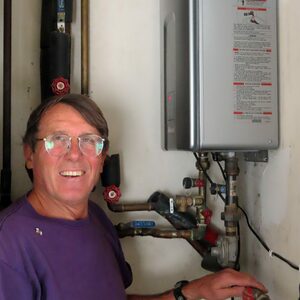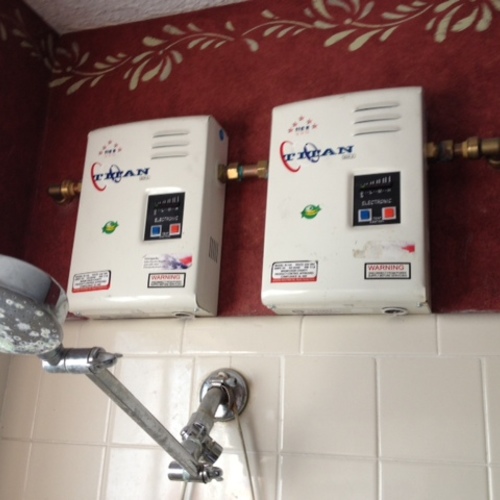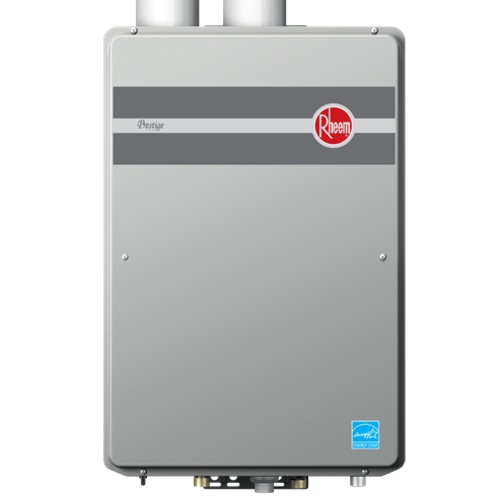
Image Credit: Charles Kiblinger via Flickr
David Voros owns a vacation home that isn’t used frequently, but every so often the house sees a lot of guests. What, he asks, is the best way of providing enough hot water for a crowd?
Voros sketches out these parameters in a recent Q&A post: very cold incoming water temperatures, a limited amount of space for a tank-style heater, and limited availability of gas. The house has photovoltaic panels, and Voros would like to avoid running another exhaust pipe through the building envelope.
For all of those reasons, he’s drawn to an electric tankless water heater. Whether that’s a good idea is the basis for this Q&A Spotlight.
Electric models need a lot of juice
The cost of operating a tankless water heater won’t be any more expensive than operating a tank-style heater, GBA Editor Martin Holladay says, but a tankless model will need an oversized electric service, and that can be expensive to install.
Weekly Newsletter
Get building science and energy efficiency advice, plus special offers, in your inbox.
“There are also disadvantages for the local electric utility, since it has to provide high-current electricity in short bursts,” he adds, “but you may not care about that.”
Dana Dorsett adds some particulars: a whole-house tankless draws more than 25,000 watts of electricity and needs a 150-amp, 240-volt breaker. The total electrical service for many houses is less than that, he adds. A typical tank-style water heater draws less than 5,000 watts, and it will have relatively low standby losses. And when Voros is away, a tank-style heater can simply be turned off.
Dorsett also points out some of the potential rate implications for Voros, who is a solar customer.
“In many locations, utilities are struggling to recover their infrastructure costs, particularly on low-use or net-zero electricity houses with solar,” he says. “The concept of applying ‘demand charges’…

This article is only available to GBA Prime Members
Sign up for a free trial and get instant access to this article as well as GBA’s complete library of premium articles and construction details.
Start Free TrialAlready a member? Log in















14 Comments
How about a high temperature tank with a tempering valve?
One way to get more water out of a small tank is to increase the temperature and add a tempering valve. Assuming incoming water at 60degF, a 20gal tank @ 200degF will provide nearly 40 gal at 140degF.
Of course, the standby losses are higher, but that can be mitigated if you only turn it up when you are there.
One of these might be helpful
One of these might be helpful for the original poster. https://aquanta.io/installation/ I could give the remote-controllablity and the temperature control that would make the system flexible for the various usages, albeit with user intervention.
Looking back I don't remember seeing anything about drain water heat recovery. I thought there was at least one horizontal unit on the market. That would increase the recovery rate of a tank and a tankless heater. In conjunction with a high temp heater and low flow shower heads, it might be enough to make tank water heater(s) viable.
Another thought. Would a
Another thought. Would a powered anode be a decent way to prevent bacteria growth without needing to keep the heater running when the house is unoccupied?
My powered anode uses 1.2W or about 10.5 kWh/year. Much less than the cost of running a water heater in standby and even much less than the cost of replacement sacrificial anodes.
Calum,
I've never heard of it before, but it seems like the purpose of a powered anode rod is the same as a passive one, which is to protect the tank. I cannot imagine how it would in any way address the concern of bacteria growth in the water. Bacteria are not going to be bothered by that tiny amount of electricity.
Solar Thermal?
Another option is a solar thermal heater with a large storage tank. When the family is away the tank can slowly heat up, over a weekend the family may not use all of the hot water available in a 100+ gallon tank. A single large tank would be most thermally efficient.
Multiple 50 gallon tanks in series could be an option with solar thermal heating on both of them and a normal electrical tank operation in the last last one as a backup for cloudy days or extended stays. The first tank would act as a tempering tank with solar assist allowing the powered tank element to work less.
Response to Joseph Malovich
Joseph,
Solar thermal equipment is so expensive that it has a long payback period, even for a full-time residence.
In a part-time residence or vacation home, the payback period is even longer, and it's hard to justify such a big investment in light of the limited energy savings.
Moreover, in a vacation home, you'd need to come up with a dump load to prevent the system from overheating -- something that can occur during sunny months when no one uses hot water for several days in a row.
HP Tank + Tankless (booster)
I've enjoyed my heat pump water heater's efficiency and it's WiFi app to remotely increase water temp and/or recovery mode (heat pump, electric resistance, or both). Family visiting? Increase temp to 140degF and switch to dual recovery. Just us?... drop it to 120degF and stick to HP recovery. All from my phone.
But if you need more than these very energy efficient water heaters can produce, I suggest an electric tankless booster, like this one https://www.ecosmartus.com/product/smartboost-7.2kw-water-heater-booster. This "in-series" tankless unit draws far less power, takes up no more space, and may provide the hot water needed for this vacation home when combined with a powerful heat pump tank heater.
utilities can care about this
I recently learned that our local electrical utility has a policy whereby they reserve the right to charge you for their costs if they find out you've installed a tankless electric water heater and as a result they have to upgrade the infrastructure on your street. Which could be big bucks, but I don't see them being very likely to carry out that threat, because I don't know how easy it would really be for them to find out you'd done that in a retrofit situation. If you're on a street that's already maxed out for what the transformer can handle, are suddenly upgrading your house electrical, at the same time that all your neighbors start to complain about their lights flickering...maybe. Anyway, worth finding out if your utility has a clause like that, especially if considering a tankless electric for new construction, where you're applying for new power and they sometimes ask what kind of water heater you'll have, or might raise an eyebrow at why a house is getting unusually high electric service.
For a vacation home? @ Harris Woodward & Joseph Malovich
Seriously folks, throwing that kind of hardware & expense at "... a vacation home that isn't used frequently..." is worse than ridiculous. Even if it has to be mounted outside in a small shed a second plain-old electric water heater + shed could cost a lot less than a solar thermal or heat pump water heater + 7kw tankless. (A HPWH + 7kw tankless doesn't come close to solving the capacity issue David Voros wants to solve either.)
Leigha: Out of curiosity, can you name the power company and location?
High power intermittent loads are a very REAL expense with potential looming problems to come, not just tankless water heaters. Without some smarts on board to allow the utility to manage them, neighborhoods full of level-2 electric vehicle chargers could potentially bring distribution grids to their knees, (and not just the local transformer.) But with smart chargers the EVs can become a welcome grid stabilizing force (unlike tankless water heaters of any size), and can even defer the need to upgrade the local transformer, despite higher net throughput of power, and even allow the integration of higher amounts of renewbles at a lower cost than stationary grid-batteries:
http://iopscience.iop.org/article/10.1088/1748-9326/aabe97/meta
It doesn't take a lot of additional smarts to schedule interruptions of the EV charging load when the local transformer is reaching it's max capacity. Most of the time the local transformer and distribution grid is operating at a single-digit or low double-digit percentage of it's maximum capacity. With smarter loads doubling or even tripling the amount of power delivered on those assets won't unduly stress them. Unlike EV chargers tankless water heaters can't be interrupted and still serve their primary function- they need that power when they need it, in real time, and a 20 second interruption would be a functional disaster, whereas an EV charger dropping out for 20 seconds so that the neighbor can wash her hands with a ridiculous electric tankless without cooking the transformer isn't a problem.
I totally agree with Dana. A tankless electric is a nightmare, especially for a vacation home that may be on a relatively extended power system. A moderate-sized HPWH can provide the capacity for the family's normal use, with some boost capacity from the electric recharge. For big crowds, use a straight electric water heater, sized to meet the demand. Put it in series with the HPWH, and turn it on only when needed.
If the house is set up with a guest suite or wing, just install a properly sized simple electric WH for that wing, located as close to the load as possible. Turn it on when you need it. Cheap and cheerful.
Some utilities are providing incentives to hook up electric WH to demand load management equipment. You might get paid to hook it up even if you rarely use it. Bonus.
When power is restored after an outage, *every* electric tank water heater turns on. Electric tank-less heaters only peak load the grid to the extent that everyone showers at the same time (they don't). I suggest that without smart management, tank heaters create higher peak loads for the grid (excepting transformer to house).
Similar issues apply to electric house heating. A peak grid load nightmare.
JonR: That would only be true if the outage was long enough for all tank heaters to drop below their setpoints, which takes many hours. Utility companies are fairly adept at staging the turn on of feeders at the substations to keep things from melting down on a cold start. Grid aware "smart" water heaters can even be used by the utility to stabilize the grid under both normal operation and cold start conditions (and the water heater owners can and are compensated for that grid service in some areas.)
The load of a single tankless is worth 4-7 standard electric tank heaters and between 25-50 heat pump water heaters, a big load that turns on & off rapidly, creating voltage & frequency disturbances the distribution grid making regulation more difficult.
Hello, I believe that for the conditions that you described in the article (periodically you need to heat a large amount of water), an electric tankless water heater is an excellent option. Since this water heater has a small size. I have a small country house and I encountered a similar problem. I decided to install an electric tankless water heater, a professional company that I found on the site - https://contractorfinder.bradfordwhite.com/contractors helped me with this. This water heater (even of small thermal power) is capable of heating a large amount of water in a short period.
Why not use propane?
Yeah, it's not cheap or particularly convenient, but for it being rarely used, it might be the easiest overall. Most people can handle carrying a couple of 40# tanks.
Log in or become a member to post a comment.
Sign up Log in